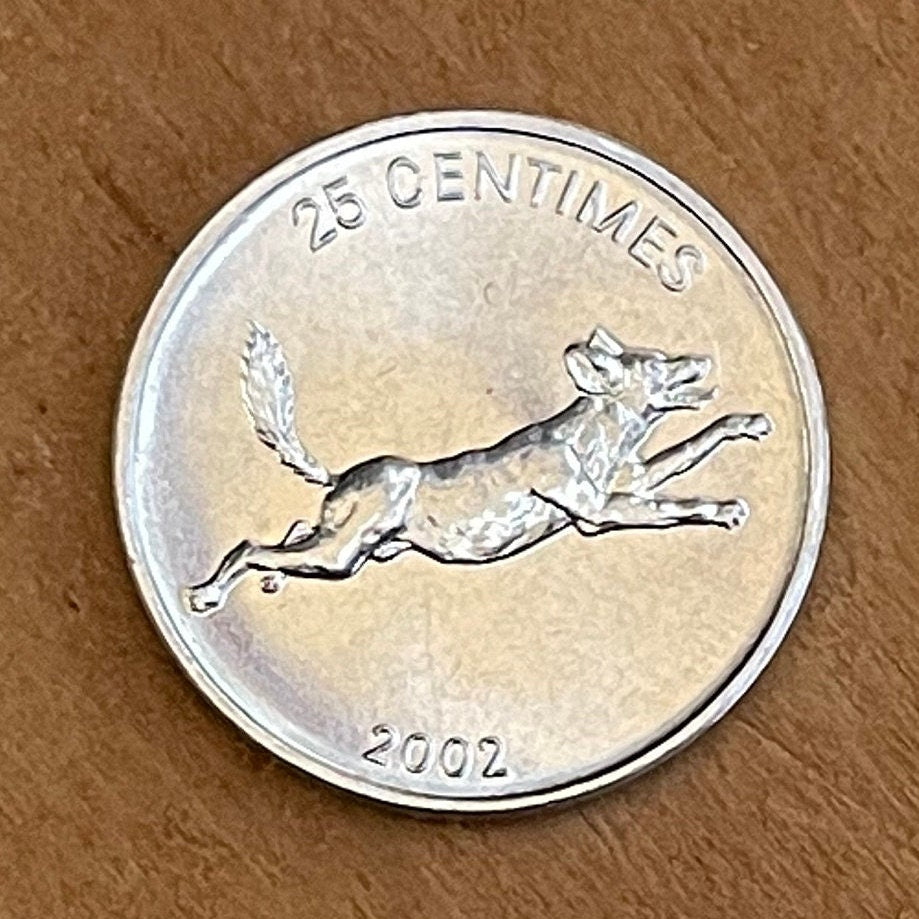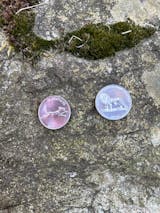elemintalshop
African Wild Dog & Lion 25 Centimes Congo Authentic Coin Money for Jewelry and Craft Making (Hunting Dog)
African Wild Dog & Lion 25 Centimes Congo Authentic Coin Money for Jewelry and Craft Making (Hunting Dog)
Couldn't load pickup availability
African Wild Dog & Lion 25 Centimes Congo Authentic Coin Money for Jewelry and Craft Making (Hunting Dog)
Reverse: African Wild Dog, leaping right.
Lettering: 25 CENTIMES
2002
Obverse: Lion to the left, name of the country above, date below.
Lettering:
REPUBLIQUE DEMOCRATIQUE DU CONGO
2002
Features
Issuer Democratic Republic of the Congo
Period Democratic Republic of the Congo › Democratic Republic (1997-date)
Type Non-circulating coin
Year 2002
Value 25 Centimes
0.25 CDF = USD 0.00012
Currency Franc (1998-date)
Composition Aluminium
Weight 0.85 g
Diameter 20 mm
Thickness 1 mm
Shape Round
Orientation Medal alignment ↑↑
Number N# 9653
References KM# 83
Wikipedia:
The African wild dog (Lycaon pictus) also called the African painted dog and the African hunting dog, is a wild canine which is a native species to sub-Saharan Africa. It is the largest wild canine in Africa, and the only extant member of the genus Lycaon, which is distinguished from Canis by dentition highly specialised for a hypercarnivorous diet, and by a lack of dewclaws. It is estimated that about 6,600 adults (including 1,400 mature individuals) live in 39 subpopulations that are all threatened by habitat fragmentation, human persecution, and outbreaks of disease. As the largest subpopulation probably comprises fewer than 250 individuals, the African wild dog has been listed as endangered on the IUCN Red List since 1990.
The African wild dog is a highly social animal, living in packs with separate dominance hierarchies for males and females. Uniquely among social carnivores, the females rather than the males disperse from the natal pack once sexually mature.
The species is a specialised diurnal hunter of antelopes, which it catches by chasing them to exhaustion. Its natural enemies are lions and hyenas: the former will kill the dogs where possible, whilst hyenas are frequent kleptoparasites.
Like other canids, the African wild dog regurgitates food for its young, but also extends this action to adults, as a central part of the pack’s social life. The young are allowed to feed first on carcasses.
Although not as prominent in African folklore or culture as other African carnivores, it has been respected in several hunter-gatherer societies, particularly those of the predynastic Egyptians and the San people.
Ancient Egypt
Artistic depictions of African wild dogs are prominent on cosmetic palettes and other objects from Egypt's predynastic period, likely symbolising order over chaos and the transition between the wild and the domestic dog. Predynastic hunters may have also identified with the African wild dog, as the Hunters Palette shows them wearing the animals' tails on their belts. By the dynastic period, African wild dog illustrations became much less represented, and the animal's symbolic role was largely taken over by the wolf.
Ethiopia
According to Enno Littmann, the people of Ethiopia's Tigray Region believed that injuring a wild dog with a spear would result in the animal dipping its tail in its wounds and flicking the blood at its assailant, causing instant death. For this reason, Tigrean shepherds would repel wild dog attacks with pebbles rather than with edged weapons.
San people
The African wild dog also plays a prominent role in the mythology of Southern Africa's San people. In one story, the wild dog is indirectly linked to the origin of death, as the hare is cursed by the moon to be forever hunted by African wild dogs after the hare rebuffs the moon's promise to allow all living things to be reborn after death. Another story has the god Cagn taking revenge on the other gods by sending a group of men transformed into African wild dogs to attack them, though who won the battle is never revealed. The San of Botswana see the African wild dog as the ultimate hunter and traditionally believe that shamans and medicine men can transform themselves into wild dogs. Some San hunters will smear African wild dog bodily fluids on their feet before a hunt, believing that doing so will give them the animal's boldness and agility. Nevertheless, the species does not figure prominently in San rock art, with the only notable example being a frieze in Mount Erongo showing a pack hunting two antelopes.
Ndebele
The Ndebele have a story explaining why the African wild dog hunts in packs: in the beginning, when the first wild dog's wife was sick, the other animals were concerned. An impala went to Hare, who was a medicine man. Hare gave Impala a calabash of medicine, warning him not to turn back on the way to Wild Dog's den. Impala was startled by the scent of a leopard and turned back, spilling the medicine. A zebra then went to Hare, who gave him the same medicine along with the same advice. On the way, Zebra turned back when he saw a black mamba, thus breaking the gourd. A moment later, a terrible howling is heard: Wild Dog's wife had died. Wild Dog went outside and saw Zebra standing over the broken gourd of medicine, so Wild Dog and his family chased Zebra and tore him to shreds. To this day, African wild dogs hunt zebras and impalas as revenge for their failure to deliver the medicine which could have saved Wild Dog's wife.
Share










Thank you for great addition
Nicely packaged, quality knife with a great weight and feel to it. Was given as a gift and the recipient was happy with their knife. Thanks!
My nephew, who stayed in Iceland briefly, will love this beautiful coin as a gift.
Bright, shiny near-mint coin with image of African Wild Dog in a joyous leap, lovely lion on reverse. Very highly recommend seller!










